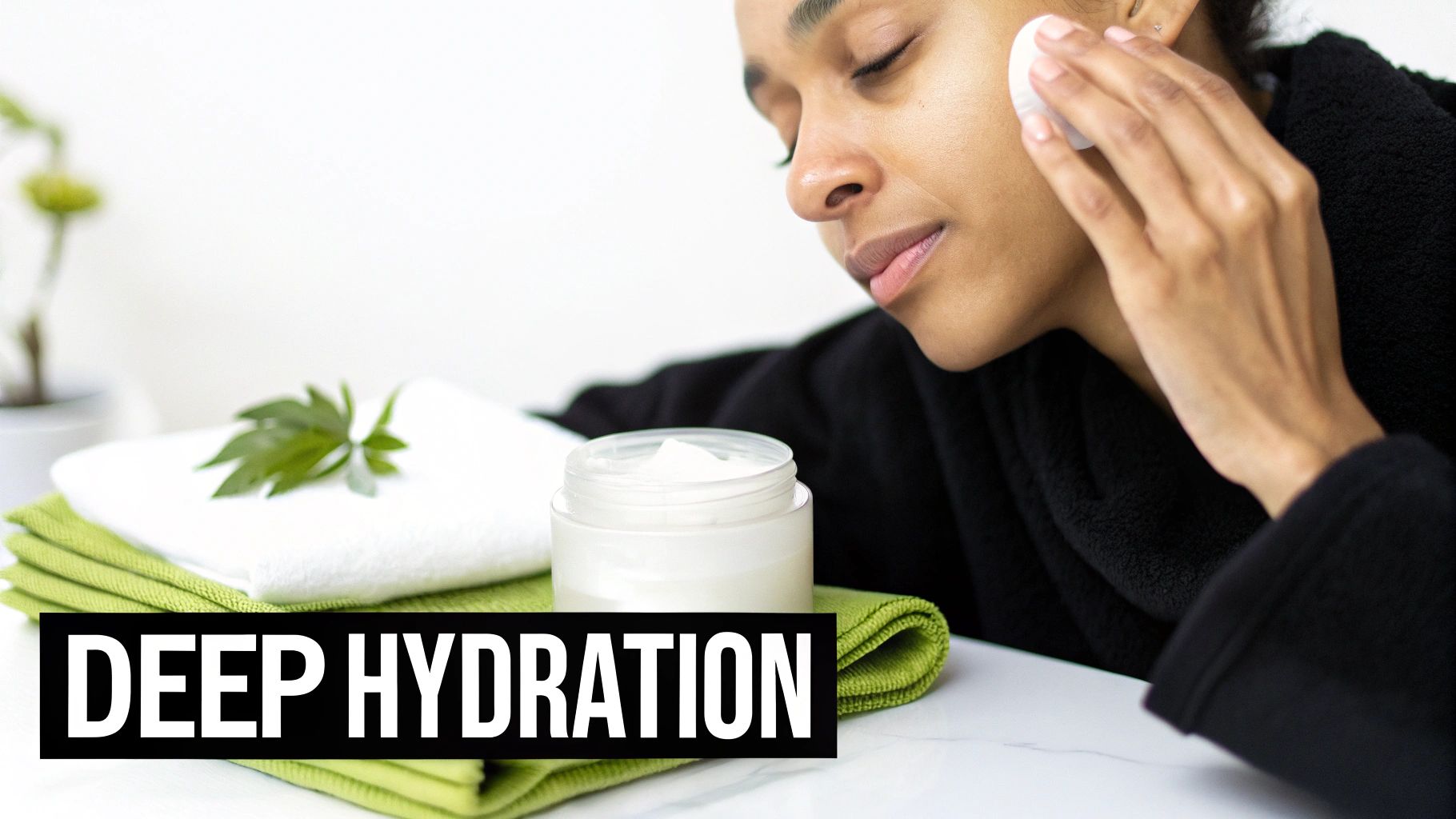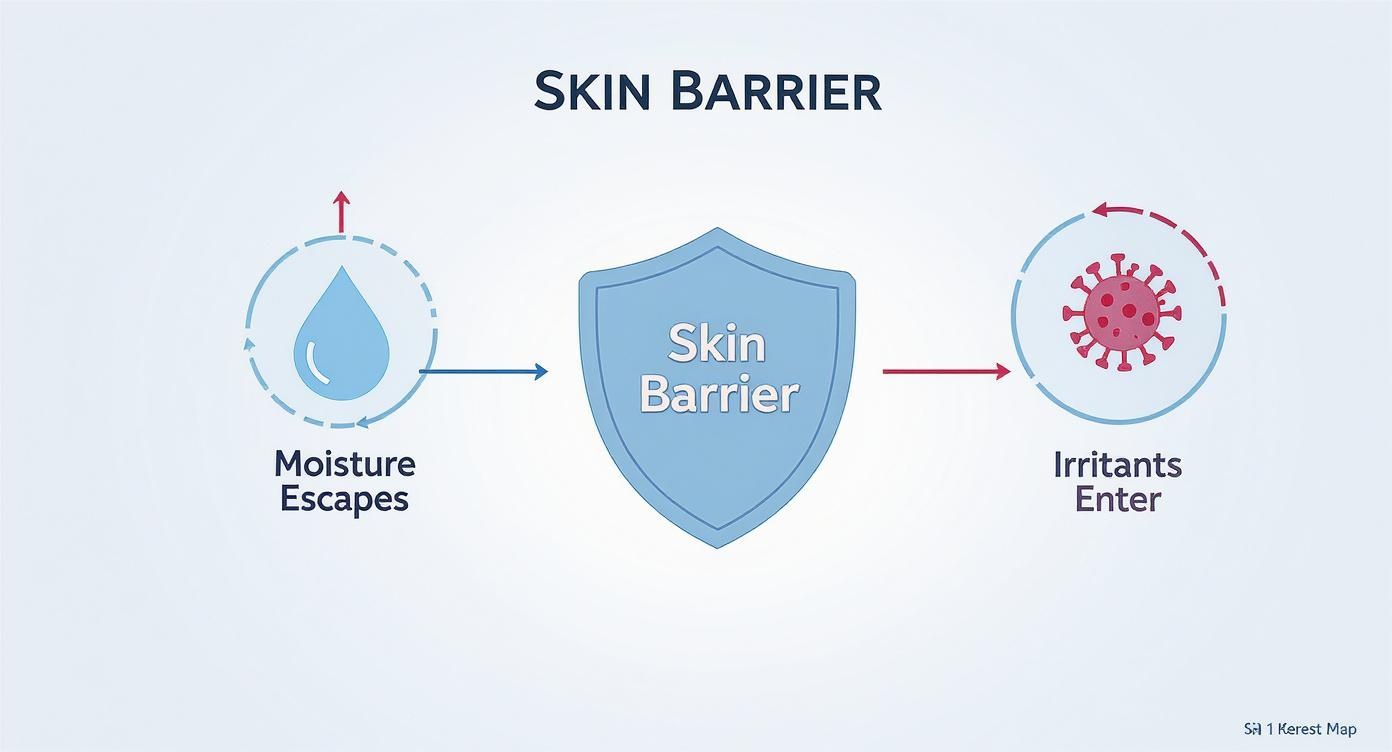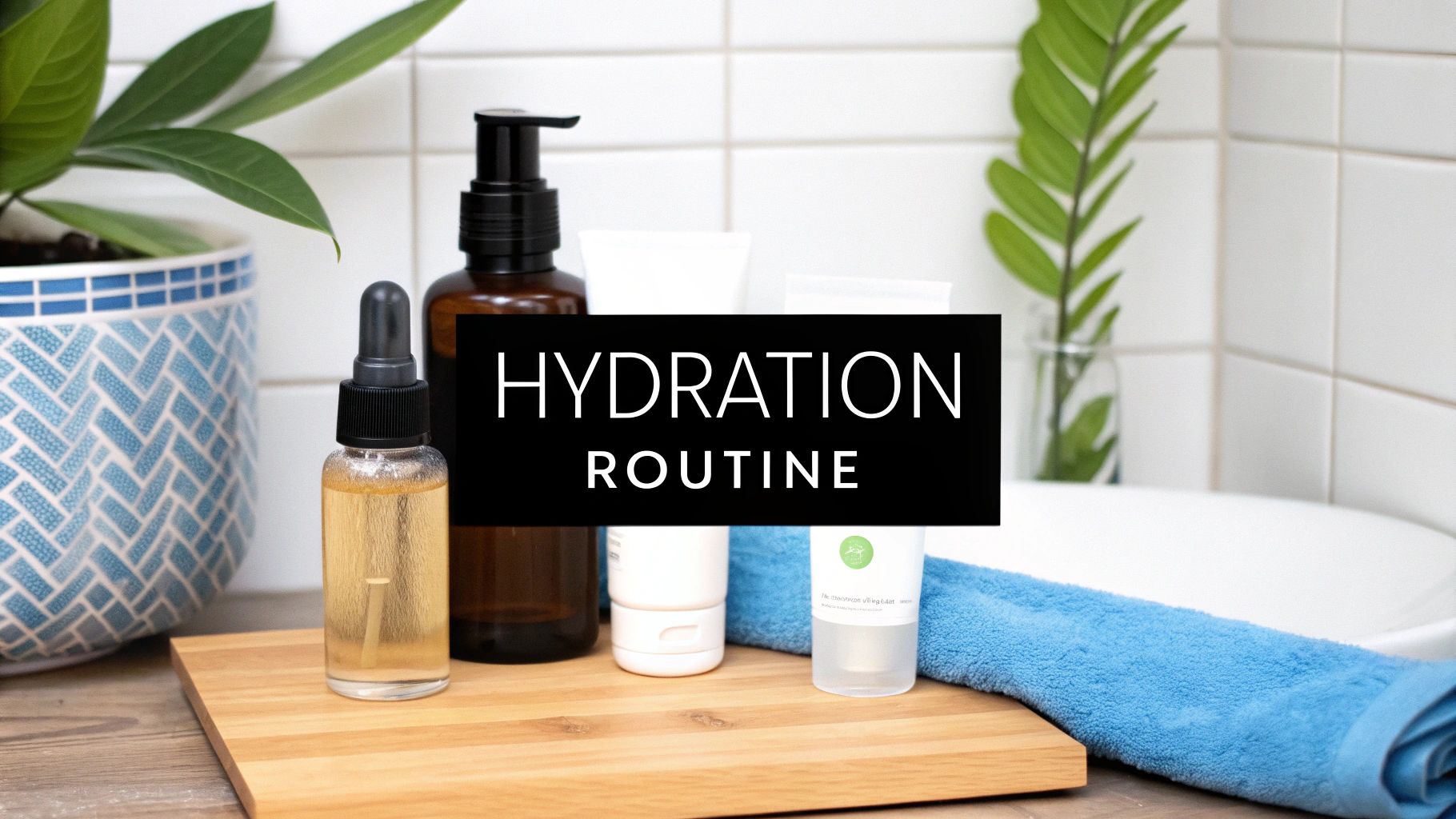Jan Elvis
30.10.2025

Jan Elvis
30.10.2025
The hunt for the perfect facial moisturizer when you have dry skin can feel like a never-ending quest. But the secret isn't some mythical, one-size-fits-all product. It’s all about finding the right combination of ingredients. The real power players—ceramides, hyaluronic acid, and shea butter—work together to rebuild, hydrate, and shield your skin. This guide is here to help you finally find lasting relief from that tight, dry feeling.

Walking down the skincare aisle can be seriously overwhelming. Every bottle seems to promise a miracle cure for dry skin, and with the global facial moisturizer market expected to reach nearly $50 billion by 2025, it's no wonder there are so many options.
The real key to success isn't trying every product on the shelf. It’s about understanding why certain ingredients are so effective. Think of this as your personal roadmap to decoding ingredient labels and picking a moisturizer that actually delivers the visible, lasting results you've been looking for.
A truly great moisturizer for dry skin does more than just slap on a temporary layer of moisture. It gets to the root of the problem by helping to repair your skin's natural barrier—the very thing responsible for keeping hydration in and irritants out.
To really tackle dryness, a formula needs a few key players. Here’s a quick look at the ingredient types that make the biggest difference.
| Ingredient Type | Primary Function | Common Examples |
|---|---|---|
| Humectants | Attract water from the air and deeper skin layers to the surface, acting like moisture magnets. | Hyaluronic Acid, Glycerin, Aloe Vera |
| Emollients | Fill in the gaps between skin cells, smoothing and softening the skin's texture for a less rough feel. | Shea Butter, Squalane, Jojoba Oil |
| Occlusives | Form a protective physical barrier on the skin's surface to seal in moisture and prevent water loss. | Ceramides, Petrolatum, Dimethicone |
When you find a moisturizer that combines these types of ingredients, you get a much more comprehensive and effective solution for dry skin.
Beyond your daily routine, exploring professional facial treatments can give your skin an intensive hydration boost. These treatments are great for tackling stubborn dryness and can really amplify the results of your at-home care.
Ultimately, the best facial moisturizer for dry skin is one that provides complete care. It should soothe that immediate tight feeling while also working to strengthen your skin's defenses for better long-term health and a comfortably hydrated complexion.
To get to the bottom of dry skin, you first have to understand what’s happening on a microscopic level. It’s helpful to think of your skin’s outermost layer—the stratum corneum—as a perfectly laid brick wall. The skin cells are the bricks, and the natural fats holding them all together are the mortar.
These fats, especially lipids called ceramides, are the unsung heroes of healthy skin. This "brick and mortar" structure is your skin’s moisture barrier, and it does two crucial jobs: it locks hydration in and keeps irritants out. When it’s working right, your skin looks and feels supple, calm, and comfortable.
But when that mortar starts to crumble, trouble begins. Gaps form in the wall, allowing water to evaporate right out of your skin. This process, known as transepidermal water loss (TEWL), is the real reason your skin feels tight, flaky, and constantly thirsty.
So, what causes the mortar to break down in the first place? Several factors can weaken your skin's defenses, and pinpointing them is the first step toward building a better routine.
It often comes down to a few common culprits:
The persistent feeling of dryness isn't just about a lack of moisture; it's a sign of a compromised defense system. Simply adding water isn't the solution—you need to rebuild the wall.
This is exactly why slapping on any old lotion won’t solve the problem. A basic moisturizer might give you a fleeting sense of relief, but it’s not fixing the root cause: a damaged barrier.
To truly make a difference, you need a formula specifically designed to replenish what's missing.
Think about our brick wall analogy again. If you saw cracks in the mortar, you wouldn’t just spray it with a hose. You’d get the right materials to patch the holes and make the wall strong again. A great moisturizer for dry skin does the same thing. It delivers ingredients that act like new mortar, filling in the gaps, sealing in hydration, and helping your skin get back to protecting itself effectively.
A great moisturizer does so much more than just feel nice when you put it on. It needs to work on multiple levels to actually bring your skin back to a healthy, hydrated state.
Think of it like building a house. You need a solid foundation, sturdy walls, and a protective roof to keep everything inside safe and sound. The very best facial moisturizers for dry skin use a similar three-part strategy, bringing together a team of ingredient types that work in perfect harmony.
This comprehensive approach is more important than ever. The global market for dry skin treatments is on track to hit nearly $43.9 billion by 2025. That number tells a story: more and more of us are looking for real solutions for our compromised skin, not just a quick, temporary fix. We need products that do more than just sit on the surface—we need them to genuinely repair and restore.
This infographic gives a great visual breakdown of how a weakened skin barrier creates the classic problems we associate with dry skin.

As you can see, a healthy skin barrier is all about balance. It keeps the good stuff (moisture) in and the bad stuff (irritants) out.
First up in our trio are humectants. These are the moisture magnets of the skincare world. Think of them as tiny, powerful sponges that actively pull water molecules from the air and from the deeper layers of your skin, drawing that hydration up to the surface. This is what gives you that immediate plumping effect and relieves that tight, thirsty feeling.
A couple of the most effective humectants you’ll see are:
Next, we have emollients. If humectants are responsible for bringing the water, emollients are there to smooth everything over and make your skin feel soft and comfortable again.
They work by filling in the tiny, invisible gaps between your skin cells, a lot like how you’d smooth spackle over a rough patch on a wall. This simple action not only makes your skin feel silky but also helps restore its flexibility and resilience.
Look for these popular emollients on the ingredients list:
Finally, we have our third pillar: occlusives. These ingredients are the protectors. They form a very thin, breathable seal over the top of your skin. This is the "roof" of our skincare house, locking in all the wonderful moisture the humectants pulled in and preventing it from simply evaporating away. This protective layer is absolutely crucial for achieving long-lasting hydration and helping your skin barrier repair itself.
An effective moisturizer has to do more than just add water. It needs to attract moisture, smooth the surface, and—most importantly—seal it all in. Without all three pillars working together, any relief you feel will be fleeting.
This powerful, synergistic combination is what separates a basic lotion from the best facial moisturizer for dry skin. For instance, a thoughtfully formulated product like our Hyaluronic Acid Face Cream is built on this very philosophy, blending key ingredients from all three categories to provide deep, lasting relief from dryness.
Alright, you know what ingredients to look for. That's a huge step. But now comes the real test: translating that knowledge into picking the right product off the shelf. The best facial moisturizer for dry skin does more than just hydrate—it needs to work with your skin's quirks and fit into your life without a fuss.
Think of it this way: you wouldn't wear ski boots to go for a summer jog. Your moisturizer needs to be the right gear for your specific skin type and conditions, not just a generic solution for dryness. The skincare market is absolutely massive, especially in North America, where it hit a value of around $2.24 billion in 2024. This isn't just random growth; it's because people are demanding smarter products packed with targeted ingredients like ceramides and hyaluronic acid to solve real problems like chronic dryness and sensitivity.
Let's be honest, skin rarely has just one thing going on. Dryness often brings along a few "friends," like sensitivity or breakouts. Your moisturizer has to play nice with all of them. The easiest way to do this is to become a pro at spotting a few key phrases on the label.
Here are the big ones to watch for:
A moisturizer can have all the best hydrating ingredients in the world, but if it irritates your skin or causes breakouts, it’s not the one for you. Always look at the big picture and match the formula to your full skin profile.
Your skin's needs change throughout a 24-hour cycle. During the day, it's on defense. At night, it's in repair mode. While you can use the same moisturizer for both, splitting them up can give your skin a serious advantage.
Day Creams
Think of your day cream as your skin's personal bodyguard. It's out there fighting off everything the world throws at it, from sunlight to city grime.
Night Creams
Once the sun goes down, your skin clocks in for its second shift: repair and regeneration. A night cream is there to support that crucial recovery process.
This day-and-night strategy isn't just a clever marketing tactic; it’s about giving your skin the right tools at the right time. For instance, that rich, reparative night cream might be the hero your skin needs during a brutal winter. If you're struggling with seasonal dryness, you should check out our guide on finding the right face moisturizer for winter to get more specific tips.

Finding the right moisturizer for your dry skin is a huge win, but its real magic shines when it’s part of a smart, supportive team. Think of your moisturizer as the star player—it can only do its best work when the rest of the routine sets it up for success. This isn't about adding a dozen complicated steps. It's about making each simple step work harder for you.
The whole point is to build a system that focuses on hydration and barrier support from the very first splash of water to the final protective layer. A great routine means that by the time you reach for your moisturizer, your skin is perfectly prepped to soak up and hold onto all that goodness.
An effective routine starts with nailing the basics. And honestly, the first step—cleansing—is where a lot of people with dry skin accidentally sabotage their efforts. Using a harsh, stripping cleanser is like trying to fill a bucket with a hole in it; you’re losing precious moisture before you even get a chance to add it back.
Instead, switch to a gentle, non-stripping cleanser. You want one that cleans your skin without leaving behind that tight, squeaky feeling. It should leave your skin feeling calm and comfortable, not desperate for moisture. Making this one simple change ensures you aren't undoing all your moisturizer's hard work.
Here’s another game-changing trick: apply your moisturizer to slightly damp skin. After cleansing, just gently pat your face with a towel, leaving it a little dewy. Applying your cream to this damp canvas helps trap that surface water, sealing it into your skin for a serious hydration boost.
A supportive routine doesn’t just add moisture; it protects the moisture you already have. Each step should be a conscious choice to either add hydration or prevent it from escaping.
Once you've got your cleansing and application technique down, you can think about adding a couple of other key players to take your results to the next level. The order you apply your products in is actually critical for making sure they all work properly. You can dive deeper into the proper skin care order of application in our detailed guide.
Here are the key layers to consider for a simple but powerful routine:
Beyond just picking the right products, following a consistent daily regimen is the real key to managing dry skin. To learn more about building your own from the ground up, check out this excellent guide on a skincare routine specifically for dry skin. This kind of framework creates a powerful synergy where each product makes the next one better, leading to resilient, deeply hydrated skin that feels as good as it looks.
Even with the perfect facial moisturizer for dry skin sitting on your bathroom counter, a few common habits could be quietly undoing all its good work. You might not even realize that these simple missteps are what’s standing between you and truly comfortable, hydrated skin.
One of the biggest culprits? Washing your face with water that’s way too hot. That steamy, comforting feeling is actually a red flag—it’s aggressively stripping away the natural oils that protect your skin, leaving it exposed, tight, and even drier than when you started.
Then there's the urge to scrub away flakes. It's so tempting to over-exfoliate, but going too hard or too often can seriously compromise your skin's delicate moisture barrier, which only leads to more irritation and moisture loss.
Beyond your cleansing routine, the way you put on your moisturizer (and your daily habits) can make or break your results. It's easy to be a little too precious with your product and not use enough. Your thirsty skin needs a generous, even layer to create a proper seal that locks in all that goodness.
And let's not forget that great skin is an inside job. If you're not drinking enough water, your skin won't have the internal hydration it needs to look and feel its best, no matter what you slather on top.
Think of it this way: correcting these small habits creates the perfect canvas for your moisturizer to perform. You're setting the stage for it to do its absolute best work, so you get every bit of benefit from your skincare investment.
Here are a few simple tweaks to get you back on track:
Making these small adjustments can completely change the game, turning a good routine into a great one.
Walking down the skincare aisle can feel overwhelming, and it's totally normal to have questions. Even after you think you’ve found the perfect facial moisturizer for your dry skin, you might still wonder if you’re getting the most out of it. Let's tackle some of the most common things people ask.
The magic number is two. For skin that feels comfortable and hydrated around the clock, make moisturizing a bookend to your day. Apply it once in the morning after cleansing to create a shield against the elements, and again at night to support your skin's natural repair process while you sleep.
What if you feel that familiar tightness creeping in midday? Go ahead and dab a little extra on any particularly thirsty spots. A small touch-up can bring instant relief without having to redo your entire routine.
Think of it this way: consistency trumps quantity. A steady morning and night routine does more to build a healthy, resilient skin barrier than a single, heavy application ever could. That's the real secret to managing dry skin.
That’s a super common fear, but a rich, creamy texture doesn't automatically mean breakouts are on the horizon. The trick is to look for one key phrase on the label: "non-comedogenic." This is your green light, signaling the formula was specifically designed not to clog pores.
Many of the best moisturizers for dry, sensitive skin are thick for a reason—they create a more effective barrier. The good ones do this using smart ingredients that deliver intense hydration without causing congestion.
Absolutely! If keeping things simple is your jam, using one go-to moisturizer is perfectly fine. That said, your skin has different needs from sunrise to sunset, so using two separate creams can often give you better results.
Think of it like this: a day cream is your skin's bodyguard, and its most important piece of equipment is SPF 30 or higher to protect you from the sun. A night cream, on the other hand, is part of the repair crew. It can be much richer and loaded with restorative ingredients, focusing entirely on healing and replenishing your skin barrier while you rest.
It's also good to remember that real change takes time. While a good moisturizer provides immediate relief, it usually takes about 2-4 weeks of consistent use to see a real, lasting shift in your skin’s health and hydration.
Ready to give your skin the deep, reliable hydration it's been craving? See what a difference Main Character can make and build a routine that helps you feel amazing in your own skin. Shop our collection now.